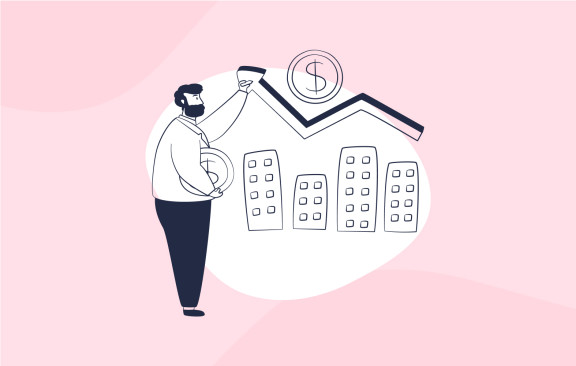Launching an online business is a significant achievement, whether you're diving into dropshipping, Amazon affiliate marketing, selling information products, Software as a Service (SaaS), or any other eCommerce venture. However, as you settle into your business, it's crucial to remember that there's always room for growth.
While your enterprise might be generating revenue, there's a wealth of untapped potential waiting to be unlocked. The key lies in smart eCommerce optimization. By fine-tuning what you’re already doing, you can close more sales and maximize profits.
This guide will walk you through the most effective strategies to optimize your eCommerce business, covering everything from store architecture to leveraging SEO. Let's dive in.
Building a Strong Foundation: The Importance of eCommerce Architecture
Your online store’s success hinges on more than just the products you sell; it’s also deeply rooted in the architecture of your website. A well-structured eCommerce site not only attracts visitors but also guides them seamlessly toward making a purchase.
Keep It Simple:
The heart of effective eCommerce architecture is simplicity. The goal is to make it as easy as possible for customers to find what they’re looking for. A widely accepted rule is that every page should be no more than three clicks away from the homepage. This “three-click rule” ensures that customers can quickly navigate your site, reducing the chances of them leaving in frustration.
An Example:
Imagine you run an online shoe store. Your site’s structure might look something like this:

This structure is clean, clutter-free, and logically organized, which makes it easy for customers to find exactly what they need. A well-architected site supports growth, improves customer experience, and boosts conversion rates.
12 Proven eCommerce Optimization Strategies to Supercharge Your Sales
With a solid foundation in place, it's time to focus on optimization strategies that will elevate your business. Here are 12 tactics you can implement to enhance your online store’s performance and increase sales.
1. Revitalize Your Virtual Storefront: The Homepage
Your homepage is the first point of contact for most visitors—it’s the gateway to your entire store. A well-designed homepage can significantly influence a customer’s first impression and their decision to stay and shop.
Highlight Your Signature Product:
Make sure your most profitable or signature product is front and center on your homepage. This draws attention to it immediately, increasing the chances that visitors will explore it further.
Showcase Special Offers:
Everyone loves a good deal. Make your special offers prominent on your homepage. This not only draws in deal-hunters but also increases the perceived value of your store.
Use High-Quality Hero Images:
Humans are highly visual creatures. The hero image on your homepage is one of the first things visitors will notice. Ensure it’s high-quality, relevant, and enticing. A stunning image will captivate visitors and encourage them to explore further.
Partake Foods showcases their popular 5-in-1 Baking Mix on their homepage, making it the focal point for visitors. This strategic placement highlights their best product and entices visitors to learn more.

But an optimized homepage is only the beginning.
2. Make Your Search Bar Impossible to Miss
Visitors to your site are there to shop, not to play games. Make it as easy as possible for them to find what they want by having an unmissable, prominent search bar. A large, easy-to-spot search bar encourages visitors to start browsing immediately.
3. Personalize the Shopping Experience
Today’s consumers expect a personalized shopping experience. Whether they’re first-time visitors or loyal customers, they want to feel valued and understood. A personalized experience can dramatically improve customer satisfaction and boost conversion rates.
Tips for Personalization:
- Device Optimization: Ensure your site provides a seamless shopping experience across all devices—whether desktop, tablet, or mobile.
- Product Recommendations: Use data such as browsing history to suggest products tailored to each shopper’s preferences.
- Geolocation: Utilize geolocation technology to offer relevant language, currency, and product recommendations based on the customer’s location.
Houzz offers a personalized search experience for first-time shoppers by allowing them to select topics of interest. This ensures that visitors only see relevant results, enhancing their shopping experience.

4. Enhance Product Photos and Descriptions
The effectiveness of your product photos and descriptions can make or break a sale. High-quality images attract attention, while well-crafted descriptions convert interest into purchases.
Photo and Description Tips:
- Showcase your products from multiple angles.
- Use a clean, neutral background to make your products pop.
- Consider 360-degree photos to provide a comprehensive view.
- Go beyond the basic features; highlight the benefits and how the product will improve the customer’s life.
- Use sensory words to create a vivid, memorable description.
- Keep your copy concise and compelling, ensuring it’s optimized for SEO with unique descriptions for each product and category.
5. Simplify the Checkout Process
A complicated checkout process is one of the most common reasons for cart abandonment. To avoid losing sales at the final hurdle, streamline your checkout process to make it as simple and friction-free as possible.
Checkout Optimization Tips:
- Minimize Steps: Reduce the number of steps required to complete a purchase.
- One-Page Checkout: Simplify the process by fitting all necessary checkout fields onto a single page.
- Guest Checkout: Allow customers to check out as a guest without needing to create an account.
PandaDoc offers a hassle-free, no-strings-attached free trial, eliminating the need for credit card details and significantly boosting lead conversions.

6. Utilize eCommerce Videos
Video content is a powerful tool for increasing conversions. From product demonstrations to customer testimonials, videos can engage customers and provide valuable information in an easily digestible format.
Benefits of Video Content:
- Increases the likelihood of purchase by 64-85%.
- Enhances search visibility, with stores using videos being 53x more likely to rank on Google’s front page.
- Keeps customers on your site longer, increasing the chance of conversion.
Video Ideas:
- Product tutorials
- Brand storytelling
- Close-up product views
- Influencer endorsements
- Customer testimonials
7. Offer Flexible Payment Options
Imagine finding all your favorite products on a site, only to abandon your cart because your preferred payment method isn’t available. This scenario is all too common and results in lost sales.
To maximize conversions, offer a variety of payment options. Focus on the methods that are most popular with your audience, and consider conducting experiments to see which options drive the most conversions.
Somnifix provides five different payment options, giving customers the flexibility to pay with their preferred method and reducing the chances of cart abandonment.

8. Leverage Customer Reviews and Testimonials
Humans are social creatures, and our purchasing decisions are often influenced by the opinions of others. Customer reviews and testimonials tap into this social proof, providing reassurance to potential buyers.
Tips for Effective Reviews:
- Use reviews from verified buyers.
- Display both positive and negative reviews for authenticity.
- Integrate reviews into emails, product pages, and even checkout pages.
- Encourage reviews by offering incentives.
9. Ensure a Mobile-Friendly Shopping Experience
In today’s mobile-first world, optimizing your eCommerce site for mobile is non-negotiable. With the majority of online shoppers browsing on their mobile devices, a mobile-friendly site is crucial for capturing and converting these visitors.
Mobile Optimization Tips:
- Use a responsive design that adjusts to any screen size.
- Simplify navigation and minimize text.
- Avoid intrusive pop-ups and ads.
- Compress images and videos for faster loading times.
Chubbies excels in mobile optimization by using a minimalistic design that fits perfectly on small screens, combined with clear and clickable CTAs.

10. Use Scarcity and Urgency Tactics
The fear of missing out (FOMO) is a powerful motivator. By creating a sense of scarcity or urgency, you can prompt customers to make a purchase sooner rather than later.
Tactics to Consider:
- Low Stock Alerts: Notify customers when stock is running low.
- Countdown Timers: Use visual countdowns to show how much time is left on a deal.
- Limited-Time Discounts: Encourage quick decisions with time-bound offers.
- Holiday Specials: Leverage holiday shopping habits with exclusive deals.
- Limited Quantity Rewards: Offer rewards to a specific number of customers.
11. Provide Irresistible Incentives
In tough economic times, shoppers are always looking for ways to get the most value for their money. Offering incentives like discounts, free shipping, or gifts can significantly boost conversions.
Incentive Ideas:
- Free Shipping: Offer free shipping for orders over a certain amount.
- Discount Coupons: Provide easy-to-redeem discount codes.
- BOGO Deals: Encourage larger orders with buy-one-get-one-free offers.
- Free Gifts: Offer a small free gift with purchase to incentivize buyers.
Zoma entices customers with a $150 discount, a specific end date, and a countdown timer, creating a compelling offer that drives conversions.

12. Optimize Your eCommerce SEO Strategy
A strong SEO strategy is crucial for driving organic traffic to your store. With 87% of shoppers starting their product searches online, optimizing your site for search engines can result in a steady stream of purchase-ready visitors.
SEO Essentials:
- Keyword Optimization: Organize your products into categories based on head keywords and target long-tail keywords for better visibility.
- On-Page SEO: Optimize title tags, description tags, and product/category pages with relevant keywords and action-oriented language.
- Link Building: Build backlinks to your store by getting listed in niche directories, guest posting, and collaborating with complementary businesses.
Making Data-Driven Decisions: The Power of eCommerce Analytics
Optimizing your eCommerce site isn’t a one-time task—it requires ongoing analysis and adjustment. By making data-driven decisions, you can continuously refine your strategies to maximize conversions and sales.
Key Data Points to Monitor:
- User Behavior: Track browsing and search history to understand customer preferences.
- Traffic Sources: Analyze where your traffic is coming from (paid ads, organic search, direct visits) to focus your marketing efforts.
- Sales Metrics: Monitor metrics like average order value (AOV) and lifetime customer value (LCV) to gauge the effectiveness of your sales strategies.
- Conversion Data: Track specific actions customers take, from landing on your site to completing a purchase.
By regularly reviewing these data points, you can identify trends and make informed decisions that drive growth.
eCommerce Optimization Is a Continuous Journey
The path to eCommerce success is paved with continuous improvement. By implementing the strategies outlined in this guide, you can optimize your store, enhance the customer experience, and ultimately increase your sales.
Remember, optimization isn’t a one-and-done task. It’s an ongoing process of tweaking, testing, and refining. But with persistence and a data-driven approach, your efforts will pay off handsomely.
So, start with these strategies today and watch your eCommerce business reach new heights.
Which part of your online store do you think needs the most improvement? Share with me in the comments below and I'll be more than happy to give you some specfic feedback!











